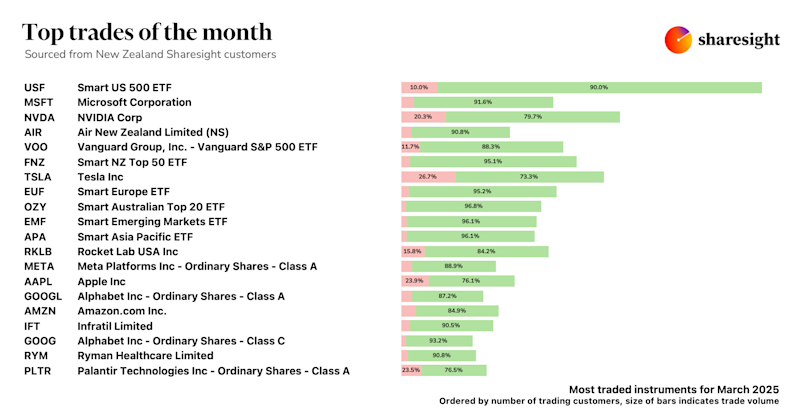Morningstar analyses Australian investors’ top trades: Q1 2025
As markets react to President Trump’s tariff announcements, we take a look at the top 20 trades made by Australian Sharesight users this quarter, and reveal where Morningstar analysts see potential opportunities.

Top trades

Two of Morningstar’s top-rated ETFs make the list. Both Vanguard MSCI Intl ETF (ASX: VGS) and iShares S&P 500 ETF (ASX: IVV) receive a Gold Medallist Rating from Morningstar analysts.
“In both cases our analysts praise the ETFs for cost efficient access to their respective indexes, broad diversification and low fees,” says Morningstar Director of Personal Finance Mark LaMonica.
“It really comes down to how the approximately 25% of VGS that is allocated to non-US developed markets performs compared to US shares.”
The two multisector offerings from Vanguard and BetaShares also earn Medallist Ratings from Morningstar analysts. Vanguard’s Diversified High Growth ETF (ASX: VDHG) earns a Silver Medalist Rating while BetaShares Diversified All Growth ETF (ASX: DHHF) has a Bronze Medallist Rating.
“These are both good ratings with the main difference being our analysts' higher conviction in Vanguard’s team,” says Mark.
“Both are good choices for investors looking for a simple way to get a diversified portfolio in one trade.”
From Morningstar’s perspective, there are some high-quality ETFs on the top trades list but investors should be wary about the impact of poor behaviour on returns.
“Overall, this is an impressive list of ETFs,” says Mark.
“It pleases me to see so many low-cost ETFs that track broadly diversified indexes. ETFs can be a great tool for investors. The key is to focus on the long-term as these are buy and hold investments. Investors tend to run into problems when they use passive investments to actively time the market.”
Morningstar’s Mind the Gap study shows the danger of this approach. The study compares the returns of funds and ETFs with the returns of the investors who’ve owned those funds and ETFs. And according to Mark, there is a difference.
“Investor returns are influenced by the timing of buy and sell decisions,” he adds.
“The gap between investment and investor returns is an indication of how poor we are at making decisions. Each poor decision is a point of failure.
"The cumulative impact was a 1.10% gap between investment returns and investor returns over the previous decade in our latest study. Collectively investors are not up to the challenge in the best of times. Now is an even more stressful time for investors and the gap has widened with increased volatility. For instance, in 2020 it increased to 2%.”
Top share trades

The top share trades in the quarter were made up of well-known US and Australian shares. Morningstar analysts provide a fair value estimate for each share they cover as well as a Moat Rating.
A moat is a sustainable competitive advantage. The imagery of a moat as a body of water to protect a castle is apt, as a moat protects a company from competition. To offer effective protection the moat must be sustainable. A company may benefit from a first mover advantage but without the protection of a moat, those advantages will be eroded over time by competitors eager to get a piece of an attractive opportunity.
A company that our analysts believe will sustain a competitive advantage for 10 years receives a narrow moat rating. A wide moat rating denotes an expected 20-year sustainable advantage. Below are Morningstar’s thoughts on five of the most popular trades.
Tesla (NASDAQ: TSLA)
Fair Value Estimate: $250
Morningstar Economic Moat Rating: Narrow
Retaliatory tariffs by China on US imports further strain trade relations between the two countries. Tesla domestically produces nearly all of its vehicles sold in China; however, a trade dispute could have a negative impact on Tesla’s brand in China as it is a US company.
Tariffs on Chinese imports also threaten to raise prices for consumers. In turn, this could lead to consumers delaying purchases of more expensive items, such as Tesla’s luxury autos.
NVIDIA (NASDAQ: NVDA)
Fair Value Estimate: $130
Morningstar Economic Moat Rating: Wide
Technology hardware supply chains are global and often concentrated in Asia. Increasing the costs of these supply chains will present immediate issues for hardware providers, through lower margins, lower demand, or a combination of both.
Under the current executive order, semiconductors are exempt, and only hard goods are being tariffed, which means services are implicitly exempt. Services would cover large swaths of the technology sector, including software, consulting and IT services.
While supply chains are global and have some flexibility, there are few places to hide under the current tariff regime, aside from bringing manufacturing back to the US. We find reshoring highly unlikely in the near term, and even if it did occur, it would be extremely costly and inflationary.
Woolworths (ASX: WOW)
Fair Value Estimate: $30.50
Morningstar Economic Moat Rating: Wide
Woolworths' Moat Rating was recently upgraded from Narrow to Wide. In Australian supermarkets, Woolworths outperforms Coles on key metrics, including operating margins, returns on invested capital, and market share. Woolworths is also the owner-operator of its fast-growing online channel, while Coles partially outsources picking-and-packing to Ocado.
Woolworths’ dominant scale allows it to leverage distribution, administration and marketing costs in a way that smaller competitors cannot. From this alone, we estimate Woolworths has a structural operating margin advantage over its closest competitor Coles.
Discounter Aldi’s Australian business is mature and we don’t forecast it significantly increasing market share. We expect warehouse Costco, expanding from a low base, to remain a minor player. German hypermarket Kaufland scrapped its plans to enter Australia in 2020.
CBA (ASX: CBA)
Fair Value Estimate: $98
Morningstar Economic Moat Rating: Wide
Australian banks won’t take any direct hit but are leveraged to Australian economic growth, which could slow. Ignoring the potential for fiscal and monetary stimulus to counter this headwind, lower economic growth generally dampens demand for new loans. Slower credit growth could also heighten price competition for a smaller pool of new loans.
Margins could also be affected in the short term if the Reserve Bank of Australia cuts rates materially to stimulate growth, as rates on transaction account balances, which pay little to no interest, can’t be cut. Provided rates don’t go back to zero, which seems highly unlikely, we expect banks to adjust loan and deposit pricing to generate adequate profits.
Despite a recent pullback, CBA is still trading as materially overvalued.
BHP (ASX: BHP)
Fair Value Estimate: $40
Morningstar Economic Moat Rating: None
With commodities such as iron ore, base metals (copper, aluminum, nickel, and so on), and coal, the potential impact from tariffs is more indirect, via potentially slower economic growth, especially in China, and hence demand for commodities.
BHP, Rio Tinto and Fortescue are likely affected. However, we think vastly higher tariffs imposed on China increase the chance of a China stimulus and, in particular, a commodity-intensive stimulus such as increased infrastructure spending along with more support for the country’s struggling residential real estate sector.
Disclaimer: The above article is for informational purposes only and does not constitute a specific product recommendation, or taxation or financial advice and should not be relied upon as such. While we use reasonable endeavours to keep the information up-to-date, we make no representation that any information is accurate or up-to-date. If you choose to make use of the content in this article, you do so at your own risk. To the extent permitted by law, we do not assume any responsibility or liability arising from or connected with your use or reliance on the content on our site. Please check with your adviser or accountant to obtain the correct advice for your situation.
Read more from Morningstar:

Sharesight product updates – April 2025
This month's focus was on improving cash account syncing, revamping the future income report and enabling Apple login functionality.

Why Strawman’s founder uses Sharesight to track performance and tax
We spoke with Andrew Page, founder of Strawman.com, about how he uses Sharesight to track his portfolio and how it benefits investors.

Top trades by New Zealand Sharesight users — March 2025
Welcome to Sharesight’s March 2025 trading snapshot for New Zealand, highlighting the top trades made by New Zealand Sharesight users.